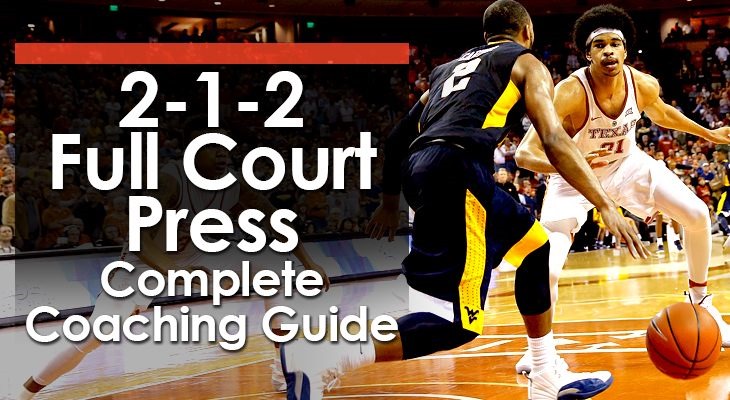
The 2-1-2 press isn’t a common choice for most basketball coaches.
While it definitely has some similarities to the 1-2-2 press and the 2-2-1 press, the 2-1-2 has just enough differences to make most coaches shy away from it.
However, it can be argued that the differences of the 2-1-2 press actually MORE effective.
Because the 2-1-2 press is set up to minimize the biggest weakness of most zone presses and also to force teams to beat it in a way most players are told to avoid.
Below you will find a detailed breakdown of the 2-1-2 press, including its rules, its setup, and how to run it effectively.
Goals of the 2-1-2 Press:
The 2-1-2 press primarily has 2 goals:
1. Keep the ball out of the middle
Most coaches teach their teams to break a zone press by getting the ball to the middle of the floor. From here, they are able to collapse the press and typically create an advantage situation after it is passed out.
With most zone presses, after a reversal or two, the defenders are late to cover the middle and there is a big hole for the offense to relocate to and receive a pass.
But since the 2-1-2 press puts a defender in the middle from the start, the middle is covered from the beginning and the rotations are shorter to keep it that way throughout the entire possession.
2. Force the offense to dribble up the sideline
The other thing most coaches teach their teams is to avoid dribbling the ball up the sideline because of how easy it is to get trapped there.
But because the 2-1-2 press takes away any pass to the middle from the very beginning, teams are forced to look up the sideline to get the ball across half court.
And once teams do start dribbling up the sideline to advance the ball, this press allows defenders to get traps set either in the frontcourt or backcourt from a variety of different players.
2-1-2 Press Rules
a. No middle passes
Again, the design of this press is to keep the ball from the middle of the floor.
With the 2nd line of the press setting up covering the middle at the beginning, there should be no real opportunities for the offense to find a hole in the middle to exploit.
b. Don’t get beat sideline
With the middle taken away, the offense is going to be forced to attempt to break the press by dribbling it up the sideline.
This can create a huge advantage for the defense if they are able to cut off the dribble and get a legal trap set.
So whatever player is rotating over to get the ball stopped and initiate the trap must get their outside foot out of bounds and prevent the ball from being dribbled past them up the sideline.
c. No layups
With two bigs at the back of the press at all times, there is no reason that the offense should be able to get to the rim for a layup.
Even if the offense is able to dribble its way through the press, there should still be a post waiting in the lane to contest any attempt the offense takes.
d. No fouling
Tight defense and trapping can make defenders vulnerable to getting fouls called.
It is imperative that the pressing players constantly show their hands to the officials to prevent any cheap hand-check calls from being whistled in the full court.
In addition, once the trap is set, the players must keep their hands high and keep themselves from swatting or slapping at the ball. Most steals from a trap are made by the players not involved in the trap after a deflection, so that needs to be the goal of the trap.
2-1-2 Press Setup, Roles, & Responsibilities
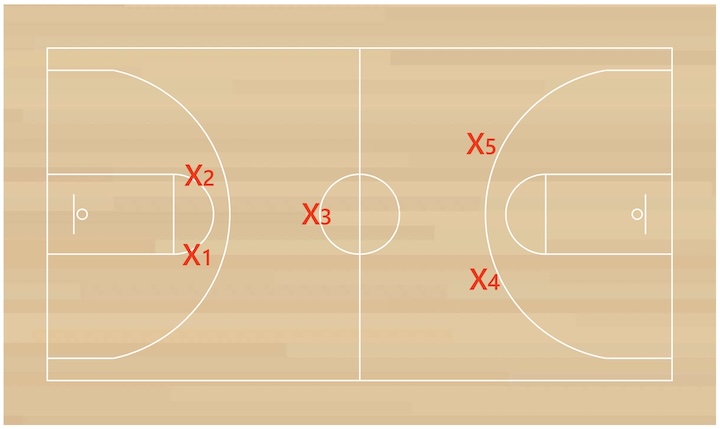
Middle Line:
Finding the right middle-line player may be the most crucial element to the 2-1-2 press.
X3 needs to be your most agile player and able to move well from side to side and anticipate where the next pass is headed. A player with length at this position is an added benefit.
X3 should begin somewhere around the front of the half-court circle in the backcourt.
The initial responsibility of X3 is to keep the ball from being passed to the center of the floor, so X3 must find and deny any offensive player near the middle.
Then, as the ball is passed in, this player needs to jump toward the ball to be prepared to set a trap while also keeping the ball out of the middle.
Once the offense begins advancing the ball up the sideline with the dribble, that is when X3 runs over to cut off the sideline, get the ball stopped, and be the initial trapper.
It is important for this player to make sure not to leave the middle too soon or it will create a large gap for the offense to throw the ball to the middle of the floor.
Also, this player must take a good angle far enough ahead of the dribbler so there is enough time to get to the sideline and get set to stop the ball legally without committing a foul.
If the ball gets thrown over X3’s head up the sideline, a second trap can get set in the frontcourt between X3 and one of the posts.
Front Line:
The front line should be the remaining two guards.
X1 and X2 should be quick players who are good at guarding the ball. Quickness and strength are added benefits for these positions.
These 2 should be situated around the elbows as the press begins.
As the ball is inbounded, whichever player is guarding it should provide enough ball pressure to keep the offense uncomfortable and also steer the dribbler toward the sideline. Letting the ball go middle will make it difficult to get a trap set.
As the ball does get dribbled up the sideline, the player on the ball must continue to guide and steer the ball toward the sideline to X3 to get the trap set. Then as the ball gets stopped, this player must complete the trap without fouling.
The player not guarding the ball should drop toward the middle of the floor and be ready to replace X3 as soon as that player leaves to trap. This player must make sure not to drop too far too fast as they need to be able to come up and pressure the ball if it gets reversed.
Back Line:
The back line should consist of your two tallest players.
X4 and X5 should be long and hopefully quick enough to be able to get from the sideline to the lane depending on the location of the ball. Having shot-blocking ability is an added benefit to these positions.
The back line should begin in the frontcourt, somewhere around the 3-point line.
As the ball is inbounded, the ball-side deep player should move toward the sideline and possibly even up the floor. This player is looking to take away any sideline pass and force the offense to beat the press with the dribble.
The weak-side deep player should get near the free throw line and be on the lookout for any deep pass to try and get a fast break score. As the ball gets advanced up the floor, the weak-side defender should continue to drop to prevent any easy scores against the press.
If a pass is made up the sideline, these deep players can be involved in a trap with X3.
How to Run the 2-1-2 Press
Inbounding & Advancing:
The defense has the choice whether to have X1 and X2 deny or not. The more crucial part is that these two guide whoever catches the ball up the sideline.
Typically, X1 and X2 would play behind and inside any offensive players so that it is easier to push them toward the sideline to make their initial catch.
On the catch, X1 puts pressure on the ball to make the offense uncomfortable and also encourages them to dribble up the sideline.
Again, they must make sure to influence the offense to attack up the side of the floor.
The point guard should not be allowed to survey the court and instead be made to feel that dribbling up the sideline is the only option.
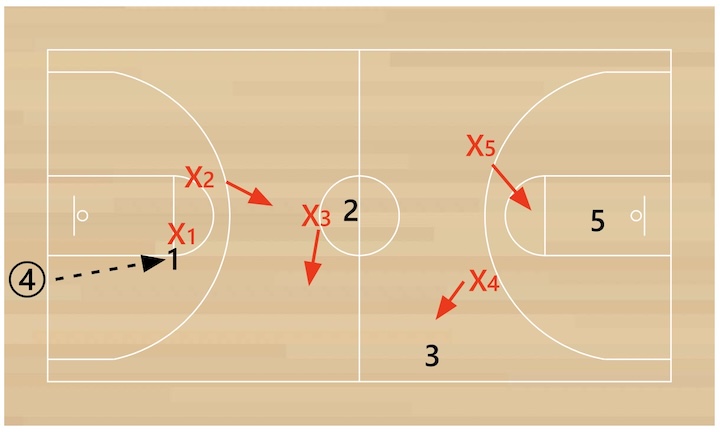
As X1 pushes the ball up the sideline, X2 drops back a little toward the middle of the floor.
X2 is basically playing between the center circle and any reversal pass.
They want to be close enough to the reversal pass that they can apply quick pressure and not let the offense dribble up through the middle of the floor.
At the same time, X3 inches out slightly away from the center of the floor to prepare to take away any sideline pass. The more athletic this player is, the farther away they can position themselves to make the pass look open before running over for a steal.
In the back of the press, X4 will move up and out toward the sideline to take away any deep passes up the sideline.
That leaves X5 left to rotate back to near the lane to be the player responsible for contesting any shots taken at the rim.
Ball Reversal:
A ball reversal is definitely not the end of the world in this press as it means the offense is continuing to use their 10-second count without really advancing the ball.
On the reversal pass, X2 will take the ball. However, the path here is very important as they should still be guiding the offense to dribble up the sideline. So a slower approach that allows the offense to continue to dribble laterally is ideal.
As the ball is being reversed, X3 should be working to stay in line with the ball and keeping the middle of the floor covered.
As the ball is reversed to the other side of the floor, the goals should again be forcing the offense to dribble it up along the sideline.
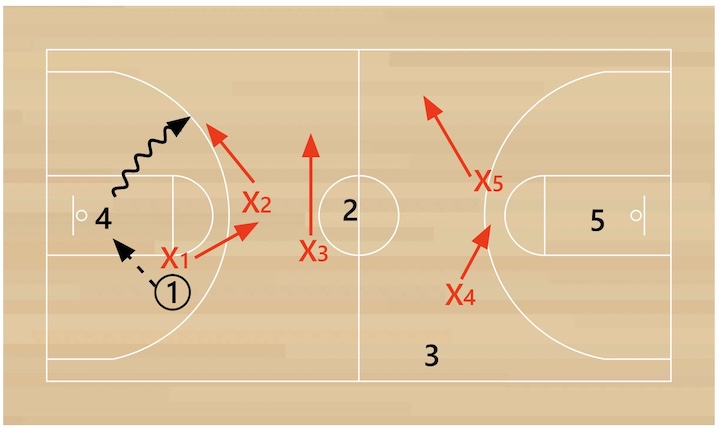
First Trap:
If X1 does the job and forces the offense to dribble up the sideline, it’s time for X3 to sprint to the sideline to get ready to trap. They must attempt to get their outside foot out of bounds to cut off any sideline drive.
X1 should continue to guard and guide the offensive player right to the waiting X3 so they can set a trap right along the sideline.
This trap can occur in either the frontcourt or the backcourt depending on how quickly X3 is able to get into position along the sideline.
But either way, it will hopefully occur as close to the 10-second line as possible.
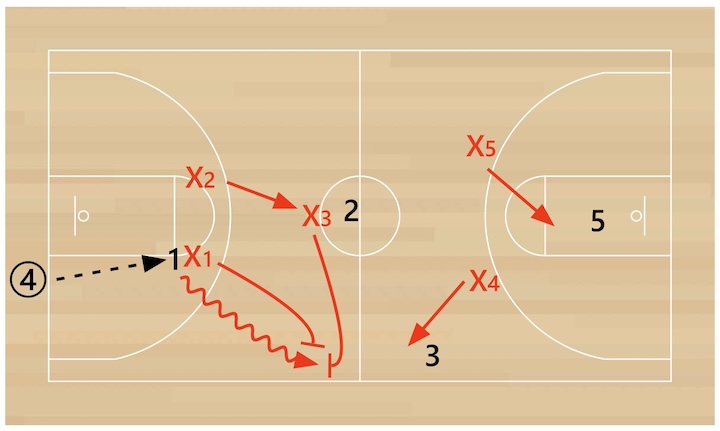
To set the best trap possible, X3 should be perpendicular to the sideline with the outside foot on the line to prevent any space for the offense to use to drive.
At the same time, X1 should be directly on the hip of the offensive player to prevent any sort of crossover to the middle of the floor.
If both players do their jobs, the result should be a tight trap along the sideline where the offense will have very limited options.
As the trap is occurring, X2 should be in the middle of the floor to take away any direct pass there. This player must be very aware of any potential flashes to this area and also be aware that the middle player could be in front or behind the 10-second line.
X4 moves up to directly take away any player up the floor near the sideline. This is a great opportunity for a steal as the offense won’t see X4 flying in to take away that player a lot of times and throw a high-arcing pass.
X5 rotates back near the lane to protect the basket. There is no reason that the offense should ever be able to throw a deep pass over the head of this player for an easy layup.
Second Trap:
Occasionally, the offense is going to complete a pass up the sideline before X4 can get there to pick it off. But this does not mean that the press needs to be called off.
In fact, this trap can actually be effective as most times the offense is not expecting it to happen there and it will often be in the hands of a player who isn’t confident with the basketball.
If a pass is completed deep up the sideline, X4 must get in front of the ball and cut off the sideline, much like X3 did in the initial trap.
Since the pass went over X3, this player is responsible for following the ball and completing the trap along the sideline.
It is likely that the offense will try to attack the basket quickly on this sideline pass, so X3 must immediately sprint and follow the ball as soon as it is passed.
X5 will continue to stay in the lane and protect the basket, which will become much more important now since the ball is so much closer.
The front line of the press, X1 and X2, must sprint back to the frontcourt and find any potential outlets for the offense and take them away. They should start by looking in the middle and then working their way down toward the basket.
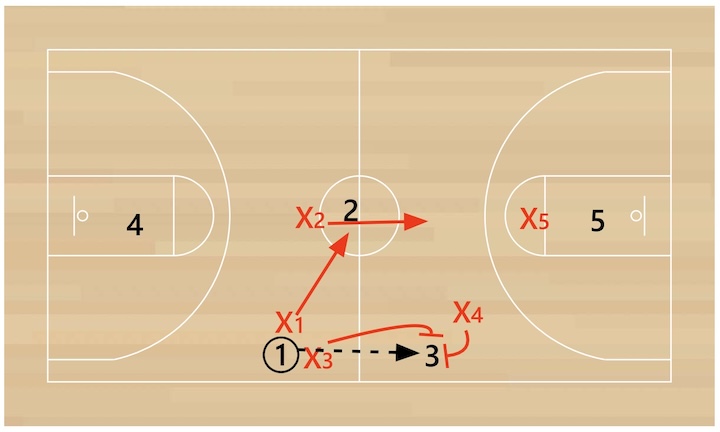
Advantages of the 2-1-2 Press
1. Strong middle coverage
Keeping the ball out of the middle is a vitally important goal of any press.
With the design of the 2-1-2 press, this goal should be accomplished each time the opponent attempts to break it.
By preventing the ball from getting to the middle, teams are forced to take more time to advance the ball across half court, giving the press more chances to work.
2. Good trapping opportunities
With the middle taken away, teams are forced to attack the press up the sideline.
This allows the defense to rotate and get great traps set along the sideline, whether it occurs in the frontcourt or the backcourt.
And with the trap occurring along the sideline, it gives the offense fewer passing options and a higher likelihood of turning the ball over.
3. Consistent basket coverage
Since there are 2 bigs at the back of this press, it allows 1 of them to always be deep and prevent any potential uncontested layup from happening.
No matter what side of the floor the ball is on, there will always be 1 big rotating to the lane to be there to make the offense have to work to score should they actually break the press.
4. Low risk press
The setup of the 2-1-2 press should prevent a lot of easy looks by the offense.
On the other hand, however, it should allow the defense to force tempo and create some turnovers while implementing it.
So the risk-reward for the 2-1-2 press seems to be very favorable for the defense.
Conclusion
The 2-1-2 press does a great job of flustering an offense by forcing them to break a press by doing something they’ve been told they shouldn’t:
Dribble up the sideline instead of getting the ball to the middle.
The 2-1-2 press is a great change-up press to use in conjunction with another press to keep the offense guessing.
If you have some athletic guards who can pressure the basketball and some posts who can cover a lot of ground, the 2-1-2 press may be something you want to try out.
